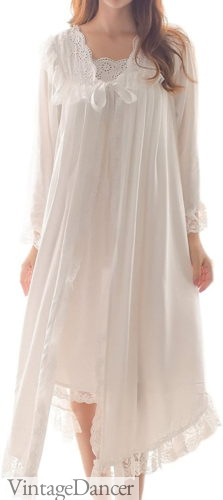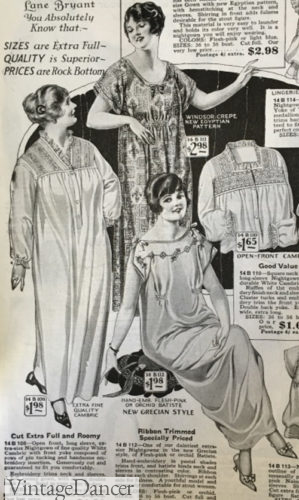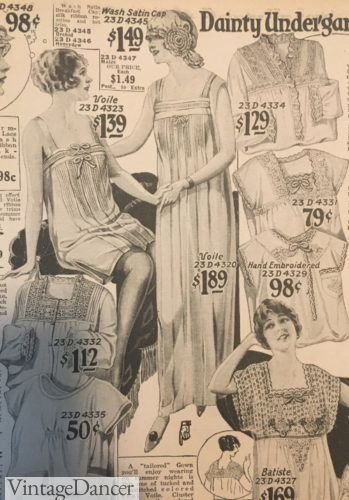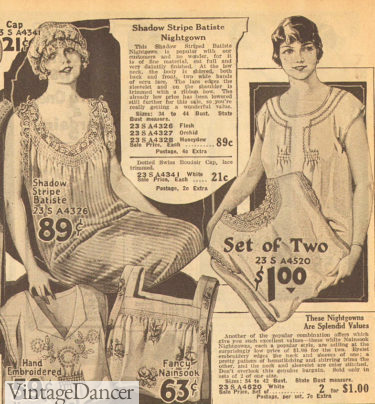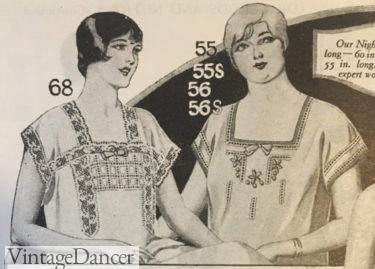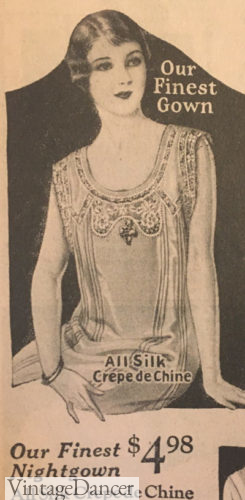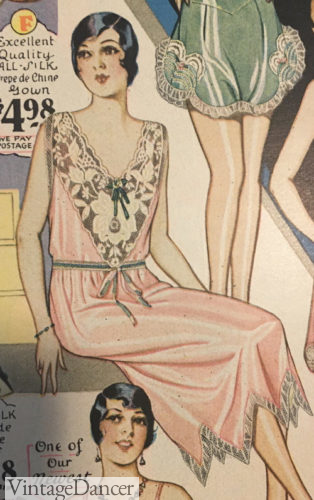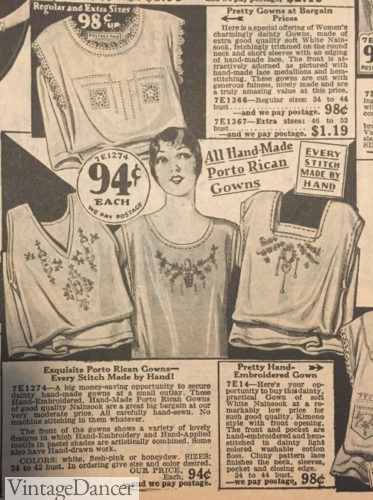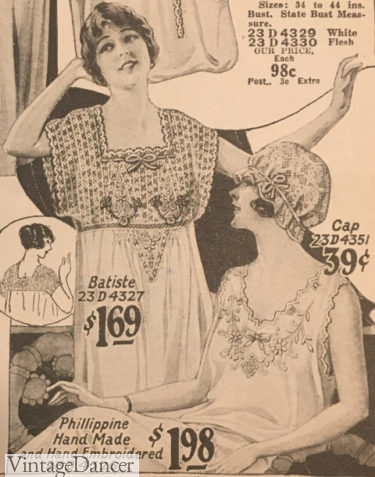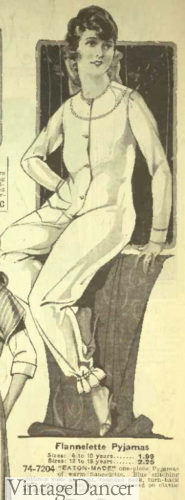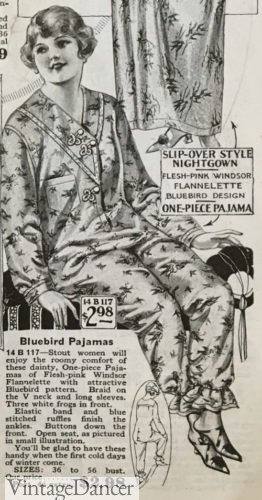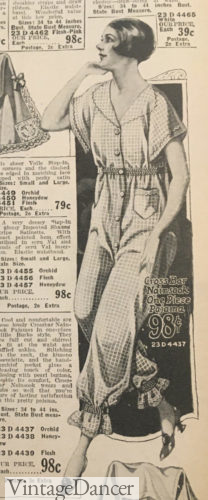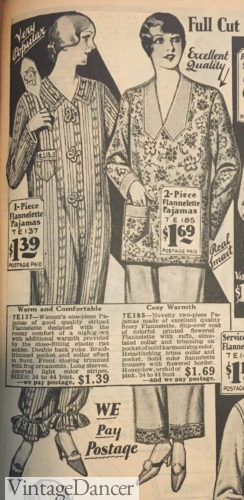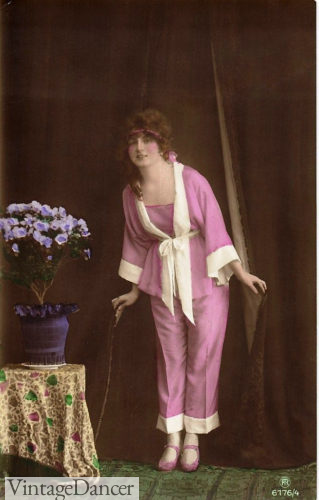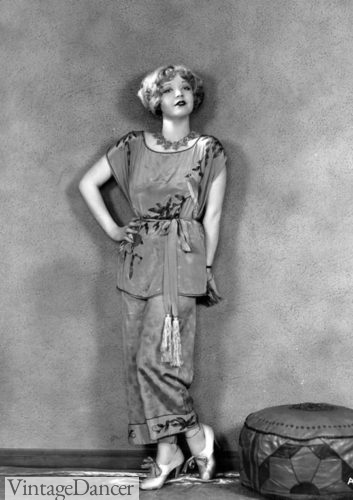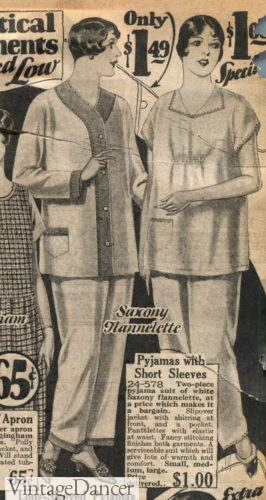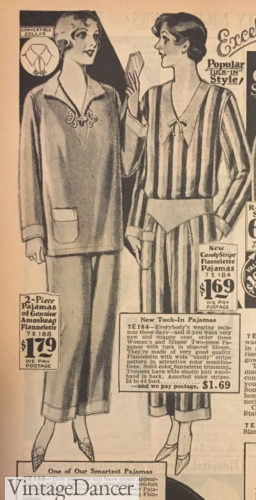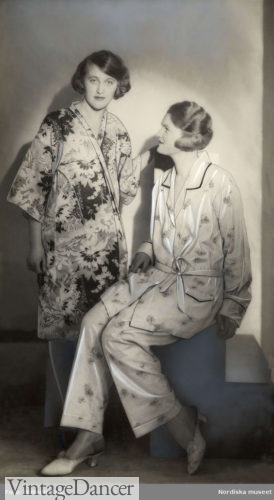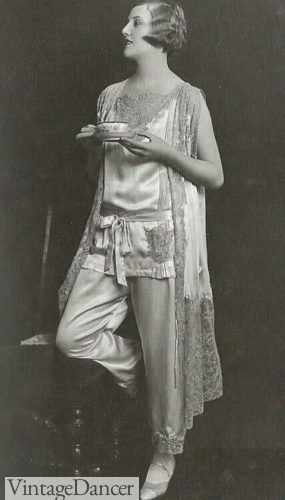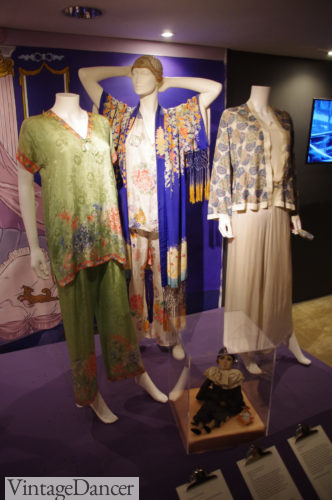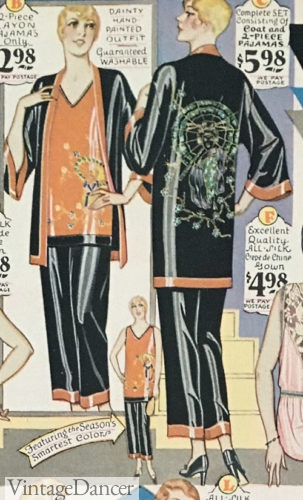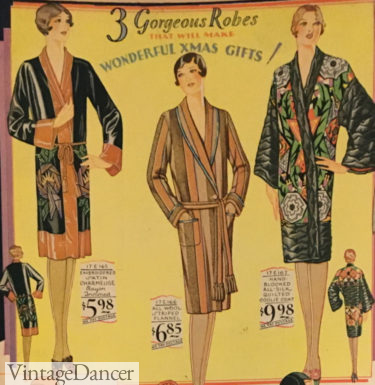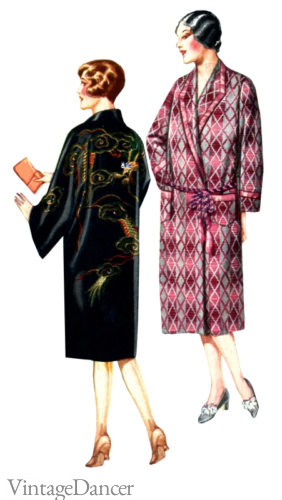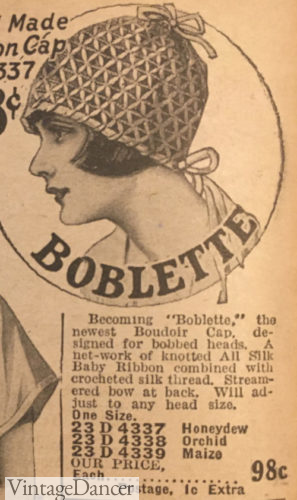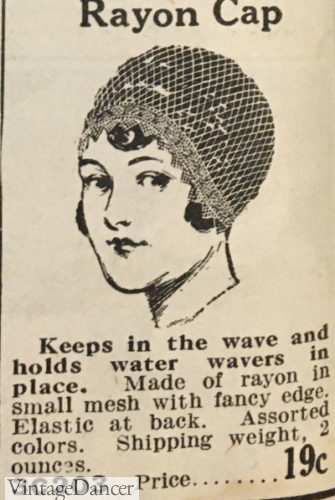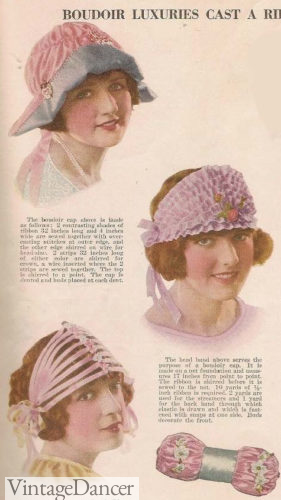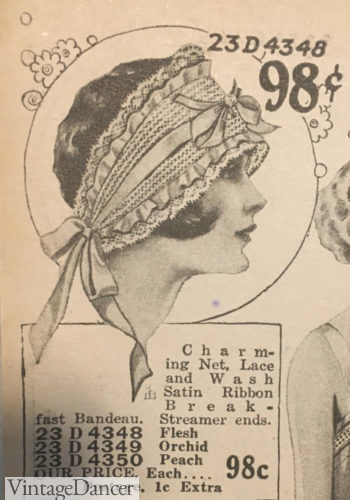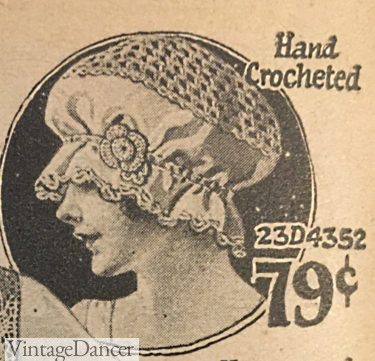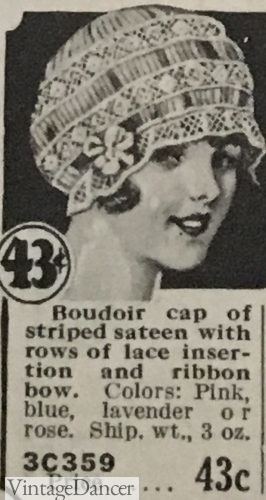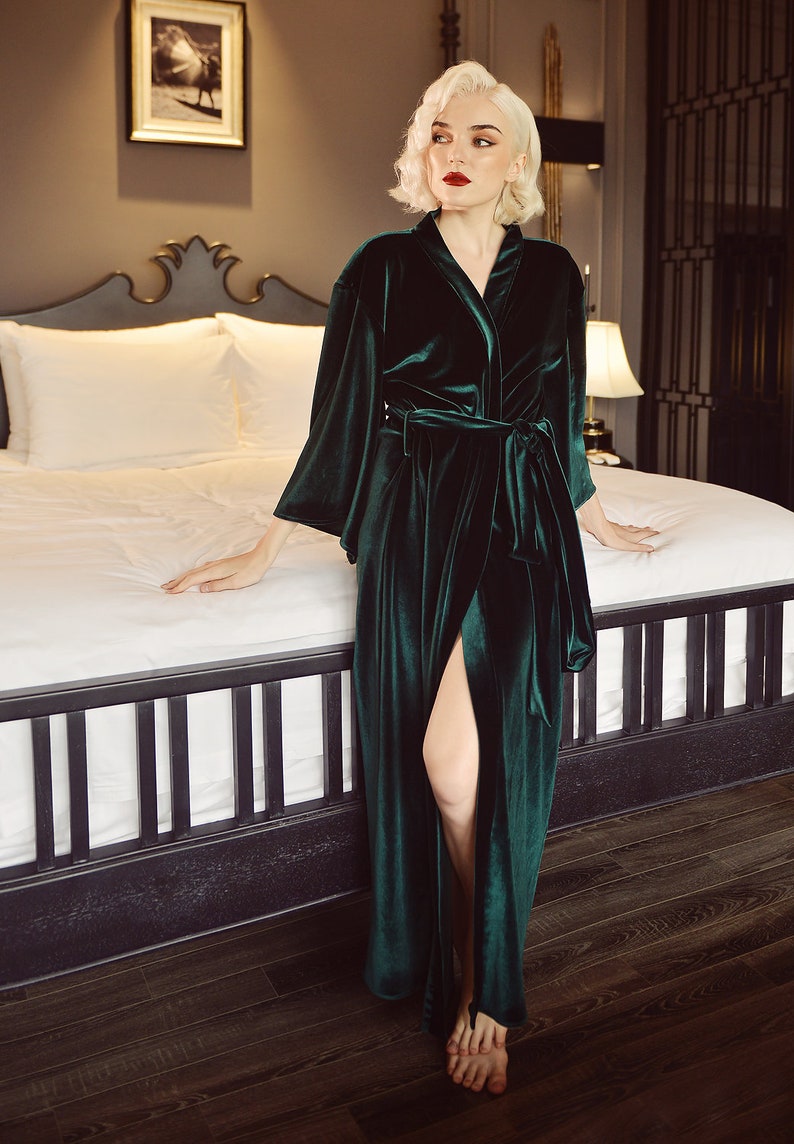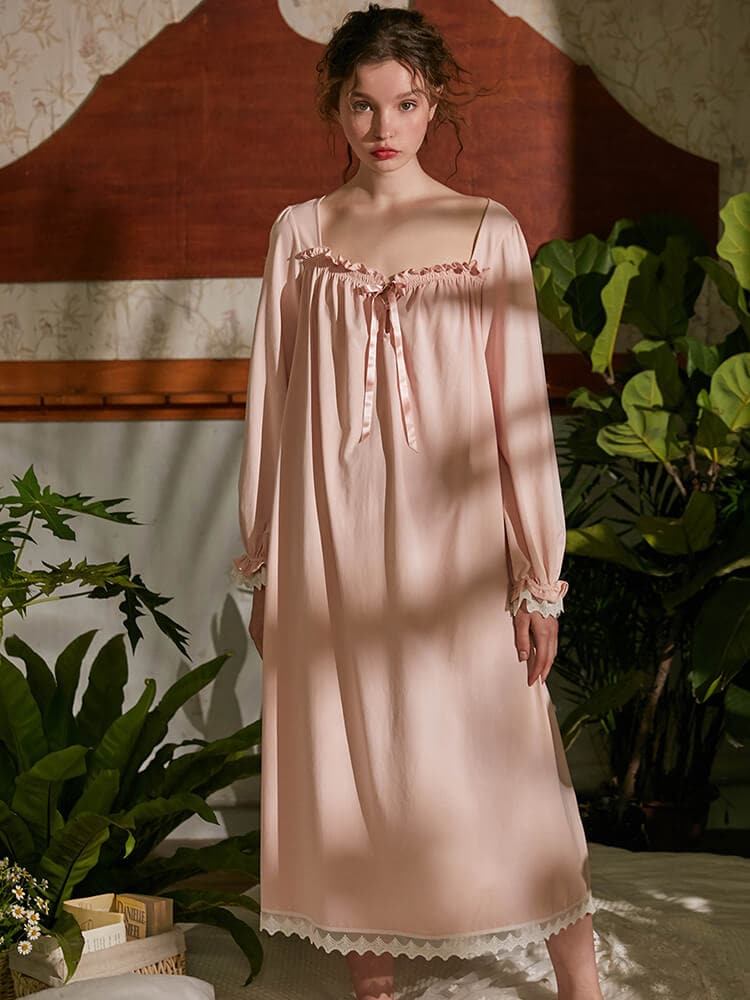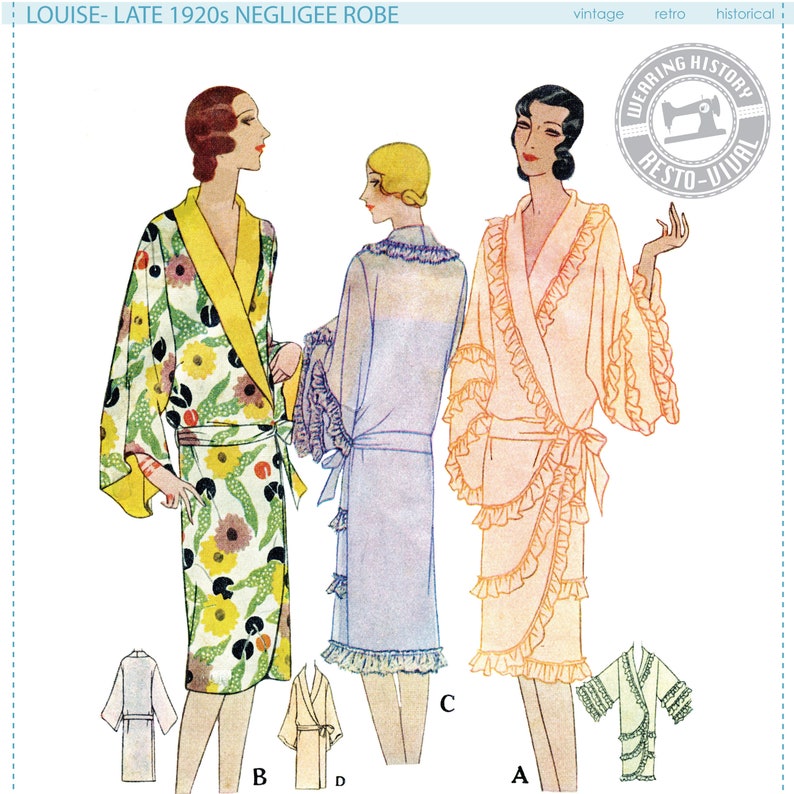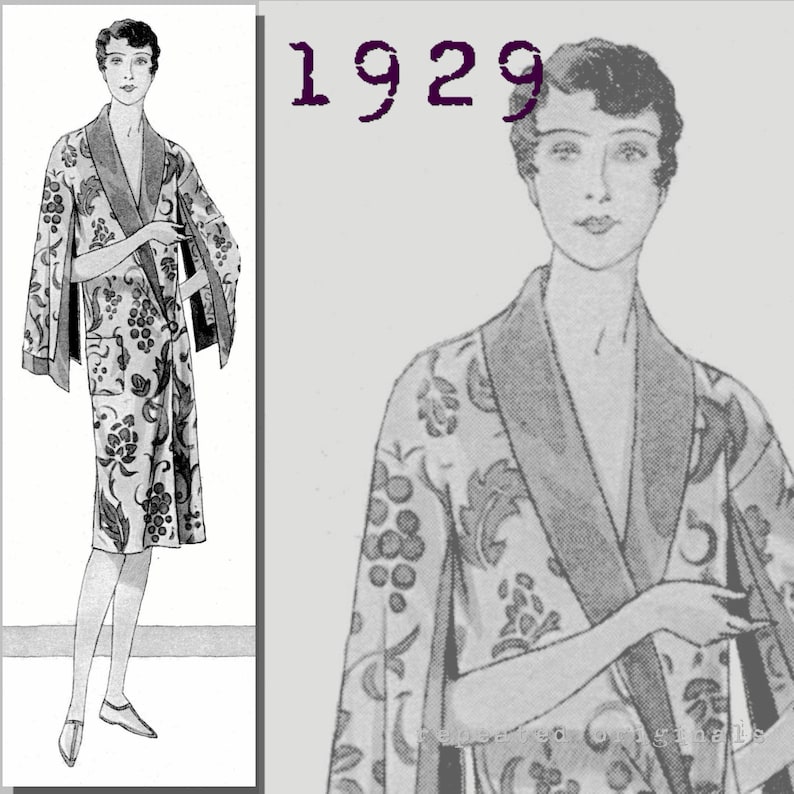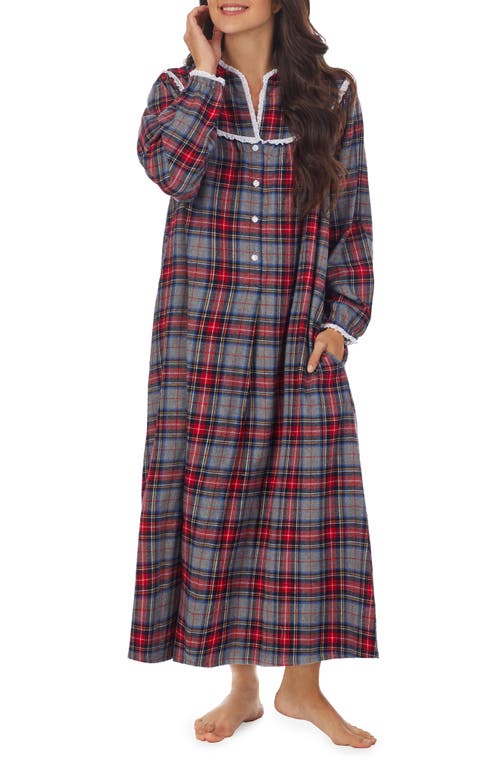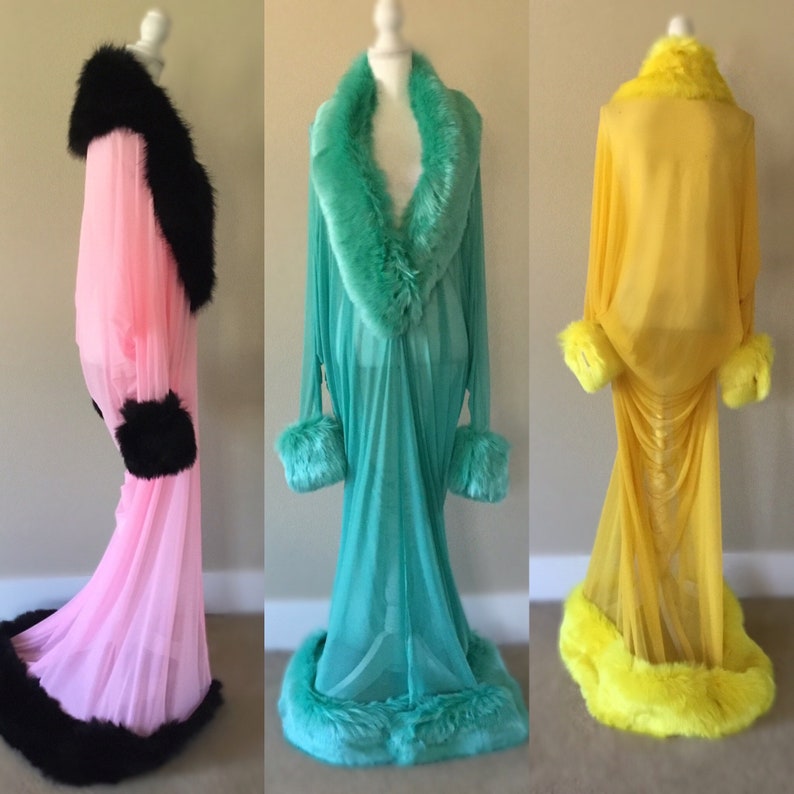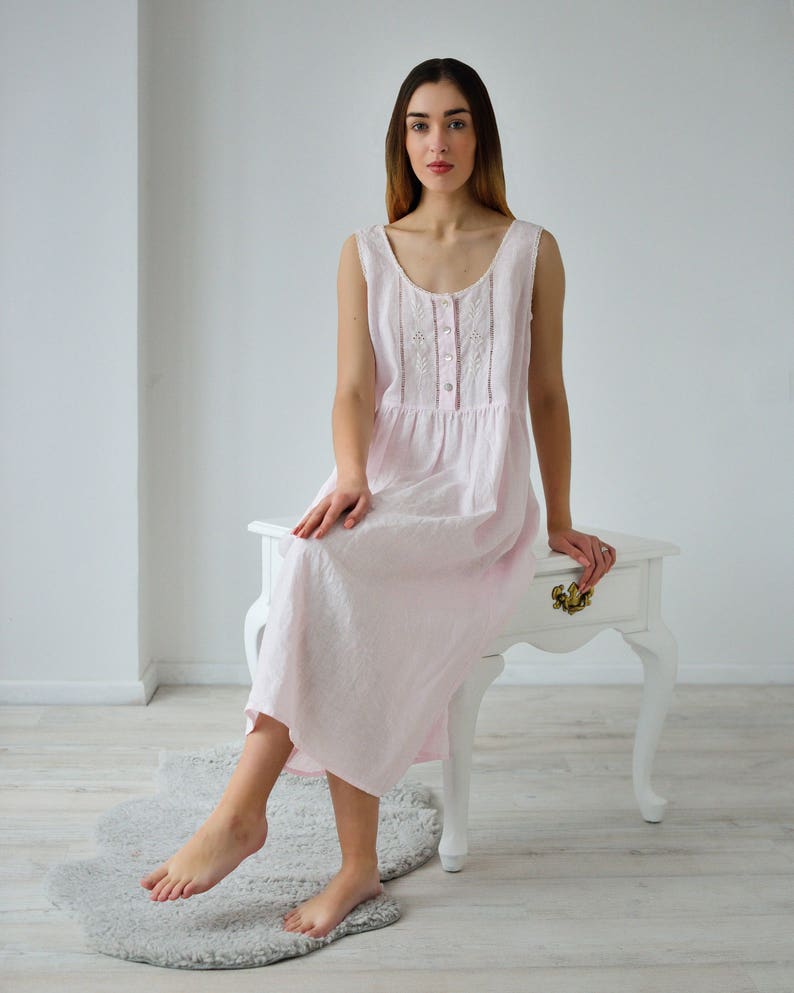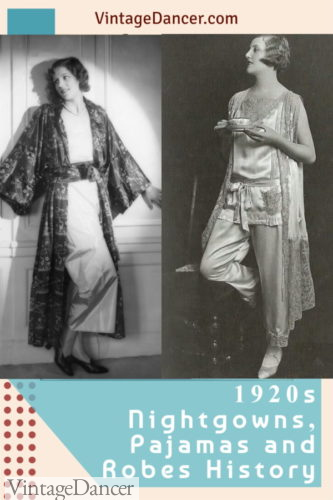
1920s sleepwear history
1920s sleepwear for women, nightgowns and pajamas, were transitioning from the practical and frilly white cotton Victorian and Edwardian nightgown to the colorful silky two piece pajama. The nightwear changes followed those of 1920s lingerie, which were slimming down to next to nothing, losing modesty, and gaining sex appeal. Women enjoyed the new lighter designs, exotic inspiration, and delicate materials. They felt pretty, even in heavier winter weight fabrics.
For men’s 1920s sleepwear history, look here.
1920s Nightgowns
Early to mid 1920s nightgowns were long ankle length pullover gowns with pretty square or V-neck necklines of lace or pintuck. They were made with the same white cotton fabric used in nightgowns of the decades past. Sleeveless in summer and long sleeved in winter, they lacked darts and even waistbands (on most). Overall, the look changed little from the Victorian era, except for a bit less fussy trim. ‘Minimal’ was the direction that nightwear was going.
- 1923 all season nightgowns
- 1925 summer nightgown
Winter versions could be made of flannel or jersey in a multitude of pink, white, and blue vertical stripes, checks, florals, blue birds, and Asian prints. They lacked collars, although faux collars made with trim like those in the nightgowns below were common.
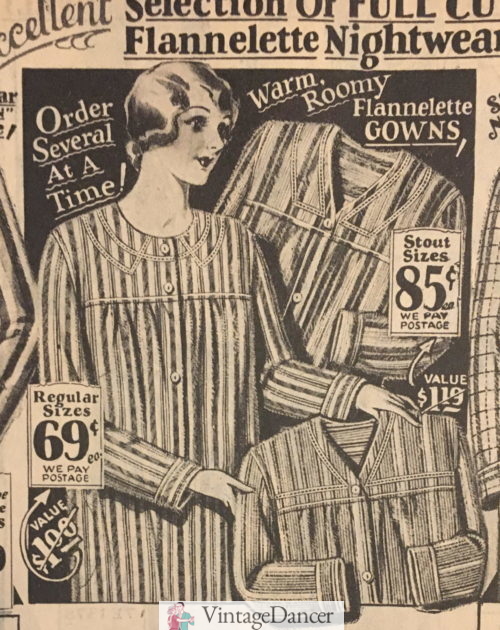
1929 flannel stripes winter nightgown
In the mid 1920s, the nightgown shifted from the matronly white cotton gown to the light and silky embroidered slip. Nainsook, silk, rayon jersey, striped batiste, voile, plisse, and satin slip-over nightgowns came in fleshy pink, white, peach, orchid, and the fashionable new color — honeydew melon green. Colored hemstitching, eyelet embroidery, small flower embroidery, topstitching, mini tucks, and little bits of lace edging were the preferred, though minimal, decoration. Large areas of soft lace emerged in the later years, lining the neckline and hems with lace edging.
- 1926 nightgowns
- 1928 embroidered nightgowns
- 1927 lace and embroidery silk nightgown
- 1929 pink with lace nightgown
The cotton batiste nightgown that was embroidered in either the Philippines or Puerto Rico had motifs inspired by the country. It was the one nightgown every woman wanted and had in the 1920s. They were advertised as having “Egyptian” embroidery, Asian medallions, tropical flowers, and exotic flower motifs. In addition, they were colorful instead of monotone, like the peasant blouses and dresses also handmade in Puerto Rico. These nightgowns were usually for summerwear with sleeveless or cap sleeves and a wide round, V, or square neckline, sometimes trimmed in a tiny bit of lace.
- 1929 Port Rico nightgowns
- 1925 handmade in the Philippines
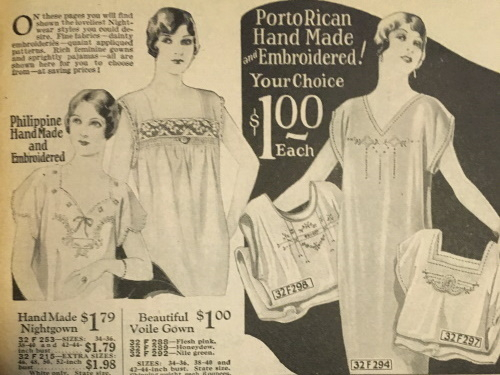
1927 Philippine and Porto Rican nightgowns
Billie Burke Pajamas
Pajamas were the newest addition to women’s sleepwear. They became more and more popular as the decade progressed, almost shoving nightgowns out of the picture by the 1930s. Their silhouette took heavy inspiration from the Far East (pajama stems from the Hindi word paejama). Read the Vintage Traveler’s four part history of women’s pajamas.
The major appeal, like most fashion in the 1920s, was that they looked like menswear, giving women the opportunity to wear pants! Some pajamas were nearly identical to men’s pajamas. Couples could purchase matching pajamas, although that wasn’t a major “trend” until the 1950s.
Named after Ziegfeld Follies star Billie Burke, the one-piece pajama or jumpsuit was not a new design to the 1920s. As a carryover from the teens, it was the first pajama or nightgown with legs. The ankles had ruffled cuffs with elastic or ties, and the front buttoned from neck to crotch or had frog clasps for more Asian style. An open crotch and drop seat made them more practical than today’s jumpsuit-pajamas.
- 1920 one-piece pajama in white flannel
- 1923 pink with blue birds in flannel
- 1925 check nainsook pajamas
- 1929 striped flannel with frog clasps
Two Piece Pajamas
The Billie Burke gave way to the two piece pajama. The matching tunic tops and wide leg pants were made not only made into sleeping pajamas but also loungewear, hostess gowns, and beach clothing: beach pajamas.
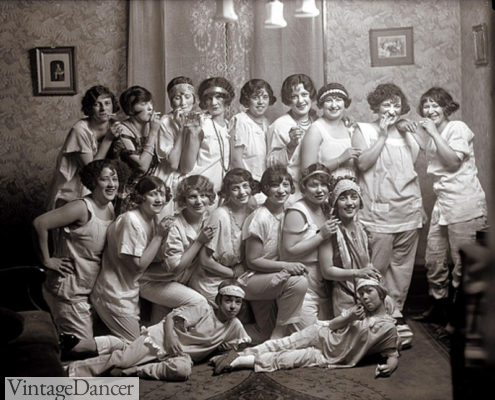
1924 pajama party!
Sleeveless, short, and occasionally long sleeved tops hung down to mid thigh with an optional sash tie. The smock top with gathered above the bust hung a little shorter than the others. Some early pajamas had a long waistband sash. Both solid and pastel colored were made into pajamas with Asian prints and delicate embroidery around the necks, cuffs, and pockets. Common materials included silk, satin, rayon, and cotton. Winter weight flannel and knitted pajamas were appreciated on cold nights. At the end of the decade, shorter tops tucked into the yoked bottoms, called the tuck-in style.
- 1920 pajamas
- Mid 20s pajamas
- 1928 button front and pull over pajamas
- 1929 tuck in pajamas (R)
- Print pajamas
- 1929 lace trim pajamas with dressing robe
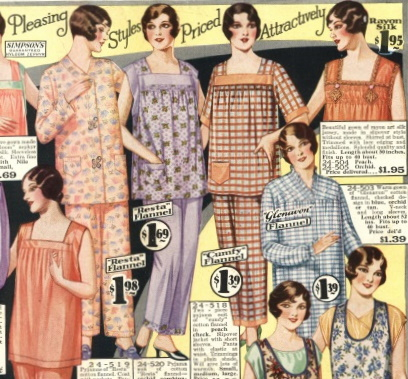
1928 smock top flannel pajamas
Pajama suits were a favorite in summer. Silk, rayon, and cotton fabric in pastel colors was common. Red and black was an Asian inspired trend. They had a lot of embroidery with floral, butterflies, and dragon patterns in the later years. Border print arms, legs, and hems were another popular ’20s trim style.
- Paul Beattie London Fashion and Textile Museum pajamas and robe
- 1929 asian inspired pajamas
Negligee, Kimonos and Coolie Coats
Many pajama suits were sold with matching Coolie Coats or short Chinese-style robes with large kimono sleeves. They were a multi-use garment traveling from the boudoir to the beach and back home as part of a hostess ensemble. Chinese colors, patterns, and trim (frogs, mandarin collars, shawl lapels, oversize pockets, contrasting cuffs) as well as Indian, Egyptian, Japanese, and Art Deco prints and designs found their way onto coolie coats.
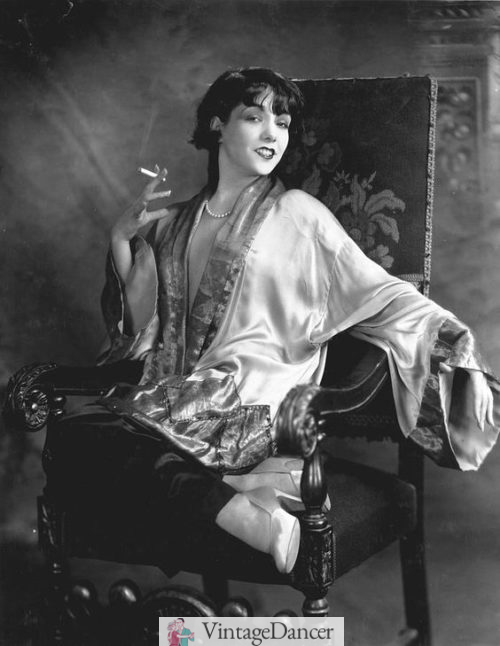
Lupe Velez wearing a coolie coat with her pajama bottoms (but no top!)
- 1929 silk robe, flannel robe, coolie coat
- Practical and Beautiful- (L) Coolie coat of black silk with embroidered Dragon design. (R) Heavy blanket cloth robe
Negligees, also know as hostess coats, were similar to coolie coats but entirely impractical. They were made of rich fabrics (velvet, crepe de chine, satin, Georgette) and heavily decorated with extra long sleeves, a mid calf length, and dramatic trim (long fringe, ruffles, panels of lace, soft fur, ostrich or marabou feathers, and ribbon flowers). They were worn over pajamas by the rich and famous who hosted house parties with their closest friends.
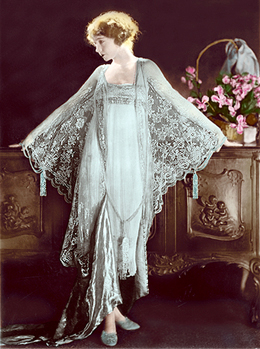
A lace negligee for the boudoir
Playing Mahjong while wearing a Kimono and slippers was very chic! The Japanese silk kimono coat was made popular 10 years earlier by designer Paul Poiret, taking inspiration from the Ballet Russe. They continued well into the 1920s with elaborate embroidery of floral, bamboo, and bird motifs.
Shop for vintage style robes and house coats.
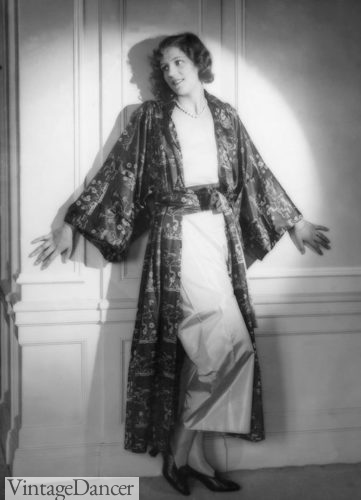
1929 Kimono robe
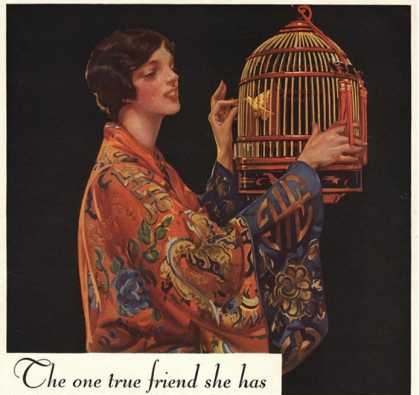
Huge Kimono sleeves
Robes
The regular classes adapted the name Negligee, Coolie coat, and Kimono to describe a house robe made of nicer fabrics with Asian prints. These were pretty and practical, making women feel like movie stars at home.
House robes came in summer and winter weights. They had large shawl collars, big patch pockets, wide cuffs, and self fabric sashes. Lighter satin material for summer with a cord tie or heavy blanket cloth or flannel in winter with fabric tie. Corduroy, velvet, and cotton were other winter fabrics. Collar types matched those of the year — shawl, fold out, sailor, Peter Pan — and were usually oversized.
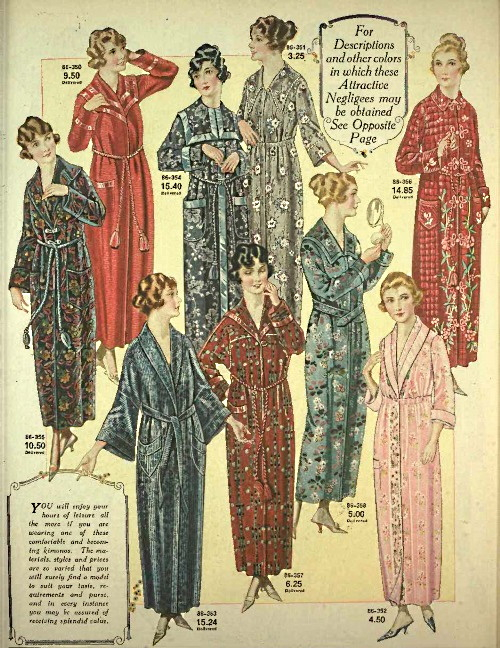
1920 winter weight robes with center tie belt
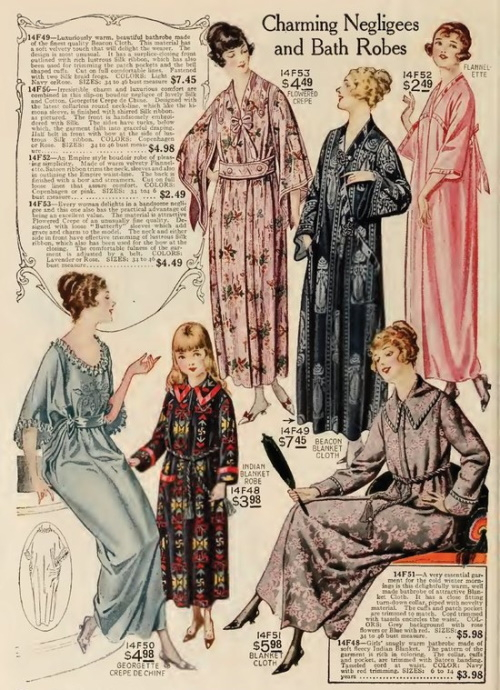
1921 all season robes
The center tying bathrobe was a gender-neutral style that prevailed in both women’s and men’s wardrobes in the same prints and styles throughout the 1920s.
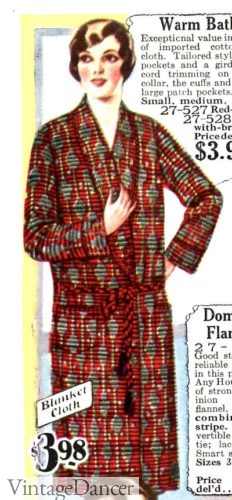
1928 blanket cloth robe
In the mid-1920s, women’s robes moved from a center wrap to the surplice-style, which tied or buttoned over the right low hip. They came in all sorts of colors and patterns such as geometric shapes, floral arrangements, argyle, and vertical stripes.
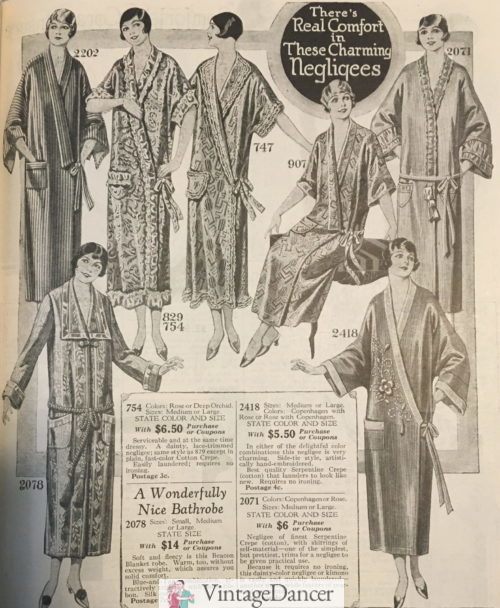
1928 surplice- style robes called here Negligees
Dressing Gowns and Bed Jackets
A robe was worn over night clothes or a dress around the house. In the bedroom, a half length dressing jacket called dressing or combing sacques were a luxury item women wore while sitting at their vanity. Something had to be worn to protect clothing from all the loose face powder and rouge makeup! They were made of crepe de chine or satin and trimmed in lace. They had one little tie in the front, enough to hold them on lightly. Women could also wear Negligees, house robes and coolie coats at the vanity.
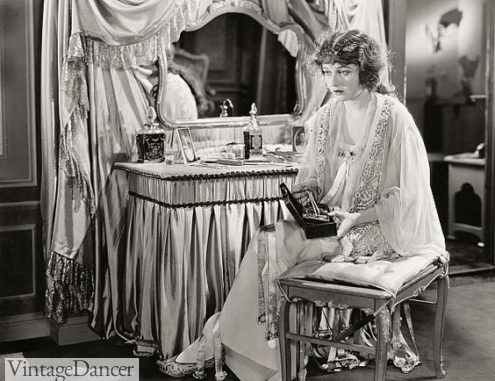
A negligee robe worn at the vanity
When dressing sacques were worn to bed, they become bed jackets. A woman might sit up and read a little before discarding her bed jacket and turning off the lamp. In winter, bed jackets were knitted and warm, but in summer, the fleshy pink color with white lace was very beautiful.
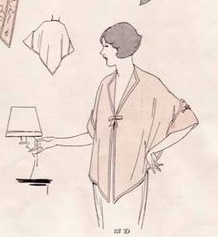
A dressing sacque- so romantic!
Boudoir Caps
When marcel hair setting was complete, the human hair or ribbon net cap was placed over the head to protect the fresh waves. Boudoir caps, light lace Bandeaus/headbands, or full head-caps covered the hair at night and stayed on until after breakfast, when a woman had time to attend to her hair and dressing. The best boudoir caps were made of silk or satin, which reduced frizz, but cotton caps were often sold with nightgowns. A hairstyle was meant to last a few days, and the bed caps were essential to making that happen.
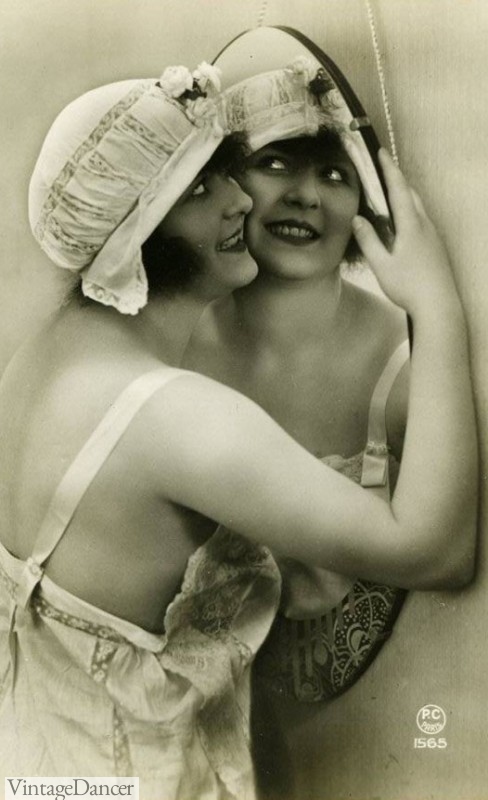
1920s Boudoir Cap
- 1925 ribbon hair net
- 1926 rayon hair net
- 1923 ribbon boudoir caps and bandeau
- 1925 boudoir bandeau
- 1925 crochet and cotton boudoir cap
- 1928 lace boudoir cap
Tip: If you ever have to sleep in pin curls or finger waves to get your hair to set, always wrap your head in a silk scarf. Not artificial silk – real silk. It is amazing how neat your hair will still be in the morning.
Slippers
House slippers were shaped like loafers, pumps, or booties and made of warm felt or soft leather in bright colors. They were edged with fur, ribbon, laces, or topped with a silk pom pom. Most had a very low heel, almost a flat soft leather sole, although slightly higher heels were placed on the Juliet models. Juliets had a higher heel back, often lined in rabbit fur, and a high tongue on the vamp too.
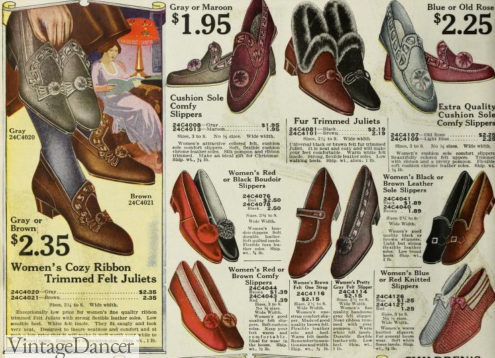
1920 slippers, Juliet on the left and top center
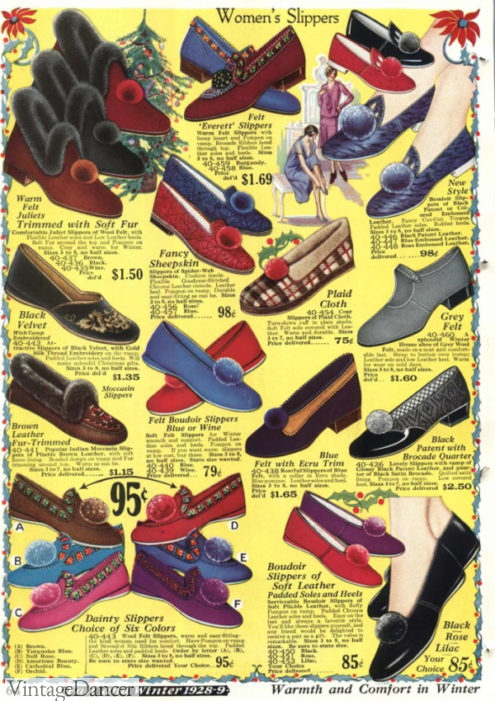
1928 slippers
Boudoir slippers were made of smooth or quilted silk, satin, or brocade and trimmed with marabou feathers, fur, or silk ribbons. They were usually slip-on mules or basic heeled pumps. They could be worn at home like house slippers, but were saved for the special outfits – paired with negligees, kimonos, and hostess coats.
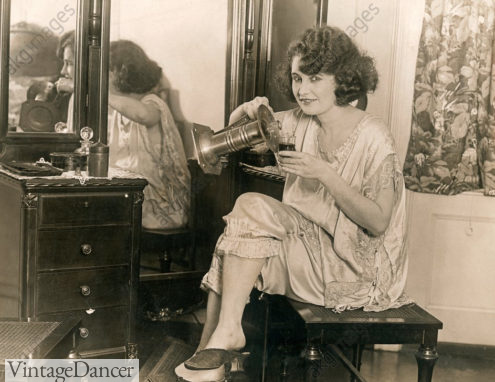
1926 pajamas and mule boudoir slippers
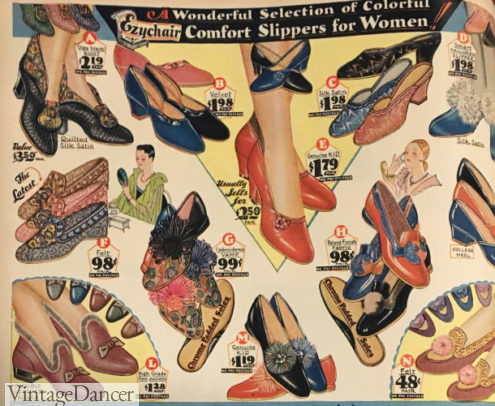
1929 slippers and boudoir shoes
Read next : 1940s Sleepwear: Nightgowns, Pajamas, Robes, Bed Jackets.
Shop 1920s Style Nightgowns, Pajamas and Robes:
Shop vintage pajamas, nightgowns and robes for all decades and shop house slippers.
Debbie Sessions has been teaching fashion history and helping people dress for vintage themed events since 2009. She has turned a hobby into VintageDancer.com with hundreds of well researched articles and hand picked links to vintage inspired clothing online. She aims to make dressing accurately (or not) an affordable option for all. Oh, and she dances too.
